Curtin Law School BLAW1004 Business Law Final Assessment, Trimester 1A
VerifiedAdded on 2022/09/13
|25
|8139
|13
Homework Assignment
AI Summary
This document presents the final assessment for BLAW1004 Business Law, undertaken by a student at Curtin University's Dubai campus during Trimester 1A of 2020. The assessment is an open-book examination and includes three parts. Part A focuses on a four-step process question related to remedies for breach of contract, specifically analyzing a scenario involving a contract dispute between an art gallery owner and a painter. Part B is an applied case study with multiple-choice questions covering performance, breach of contract, remedies, and negligence. The case study revolves around a florist and plant supplier. The final section, Part C, is not included in the provided text. The assignment emphasizes the application of legal principles to real-world scenarios, requiring students to demonstrate their understanding of contract law and related concepts.
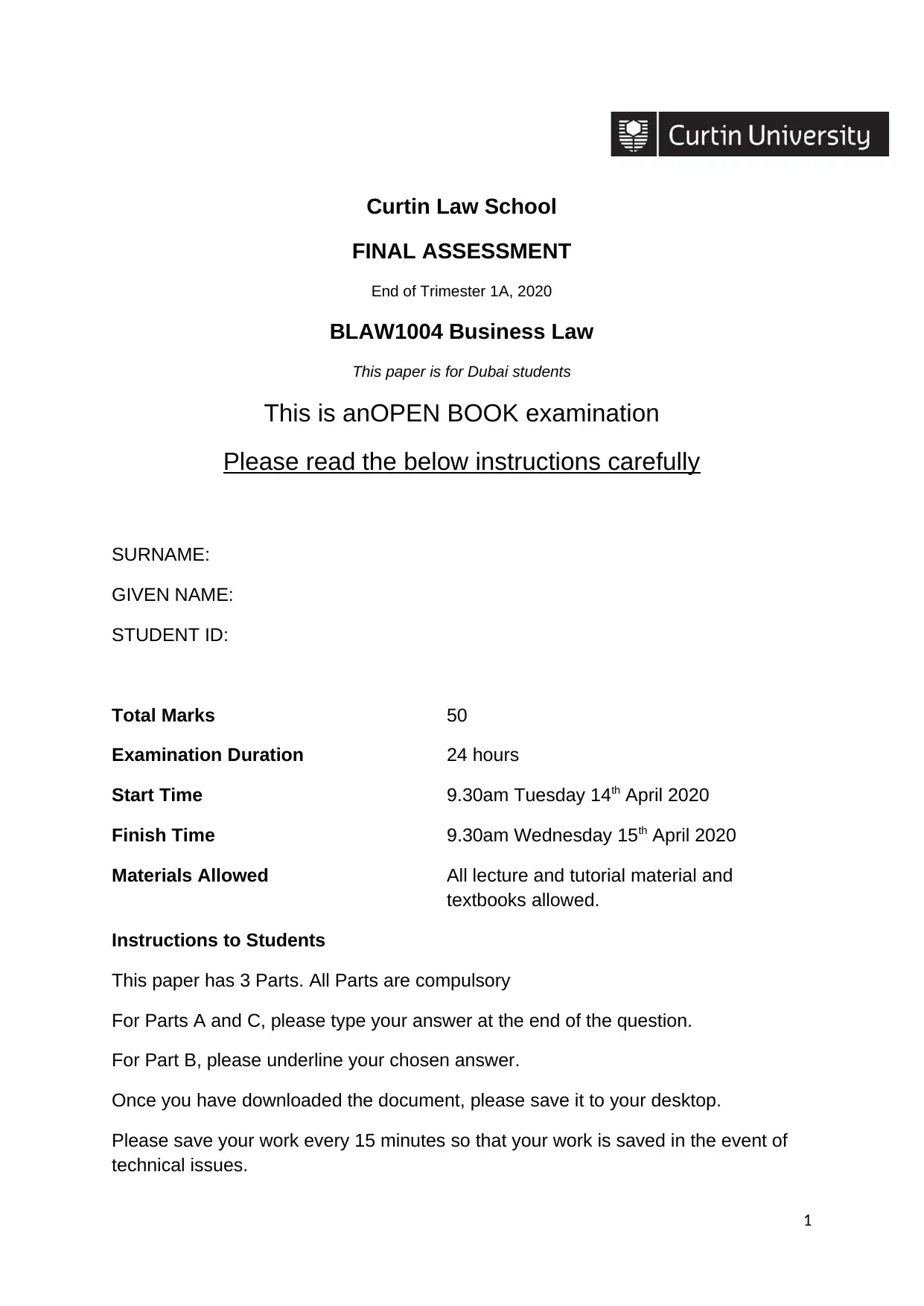
Curtin Law School
FINAL ASSESSMENT
End of Trimester 1A, 2020
BLAW1004 Business Law
This paper is for Dubai students
This is anOPEN BOOK examination
Please read the below instructions carefully
SURNAME:
GIVEN NAME:
STUDENT ID:
Total Marks 50
Examination Duration 24 hours
Start Time 9.30am Tuesday 14th April 2020
Finish Time 9.30am Wednesday 15th April 2020
Materials Allowed All lecture and tutorial material and
textbooks allowed.
Instructions to Students
This paper has 3 Parts. All Parts are compulsory
For Parts A and C, please type your answer at the end of the question.
For Part B, please underline your chosen answer.
Once you have downloaded the document, please save it to your desktop.
Please save your work every 15 minutes so that your work is saved in the event of
technical issues.
1
FINAL ASSESSMENT
End of Trimester 1A, 2020
BLAW1004 Business Law
This paper is for Dubai students
This is anOPEN BOOK examination
Please read the below instructions carefully
SURNAME:
GIVEN NAME:
STUDENT ID:
Total Marks 50
Examination Duration 24 hours
Start Time 9.30am Tuesday 14th April 2020
Finish Time 9.30am Wednesday 15th April 2020
Materials Allowed All lecture and tutorial material and
textbooks allowed.
Instructions to Students
This paper has 3 Parts. All Parts are compulsory
For Parts A and C, please type your answer at the end of the question.
For Part B, please underline your chosen answer.
Once you have downloaded the document, please save it to your desktop.
Please save your work every 15 minutes so that your work is saved in the event of
technical issues.
1
Paraphrase This Document
Need a fresh take? Get an instant paraphrase of this document with our AI Paraphraser
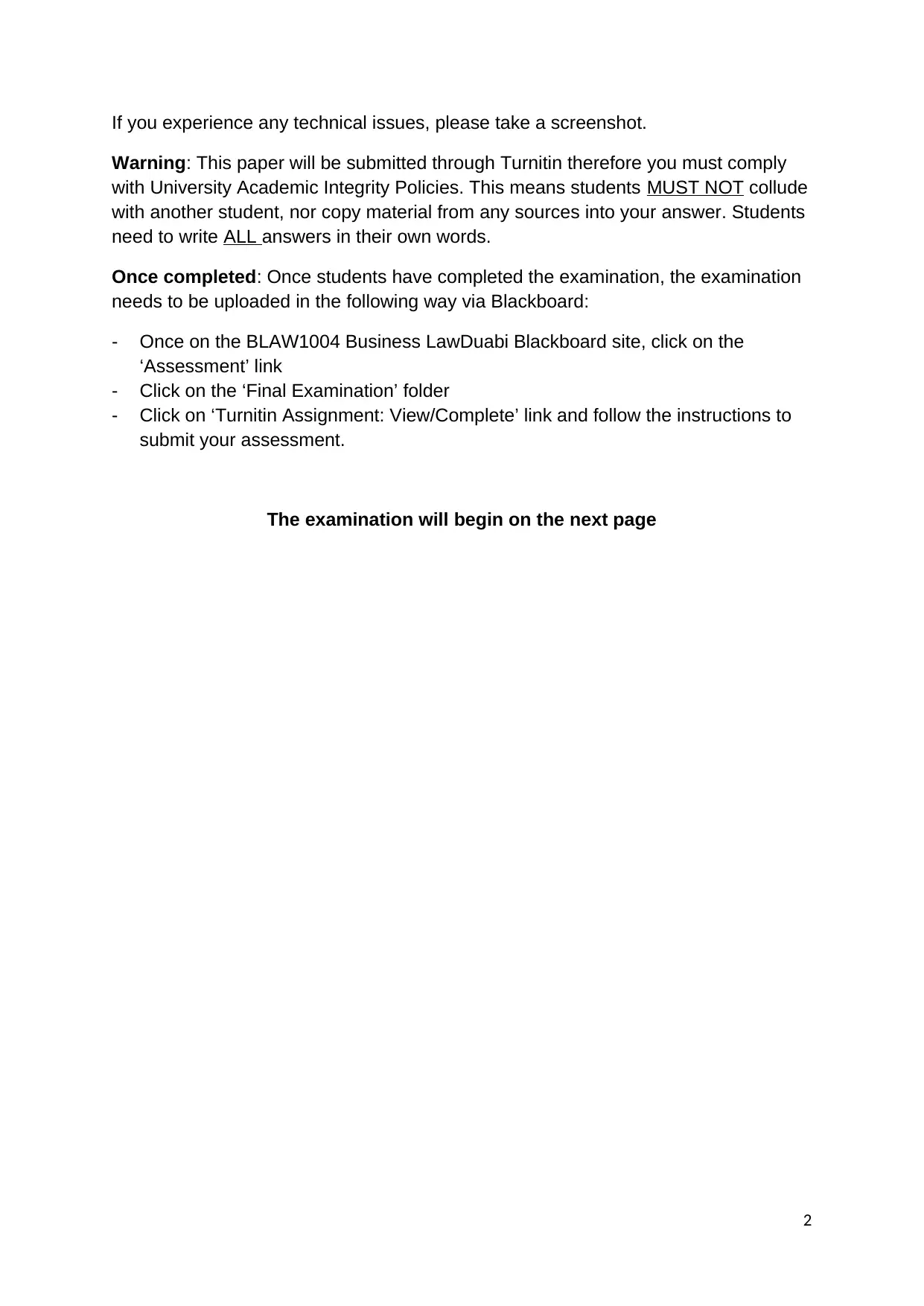
If you experience any technical issues, please take a screenshot.
Warning: This paper will be submitted through Turnitin therefore you must comply
with University Academic Integrity Policies. This means students MUST NOT collude
with another student, nor copy material from any sources into your answer. Students
need to write ALL answers in their own words.
Once completed: Once students have completed the examination, the examination
needs to be uploaded in the following way via Blackboard:
- Once on the BLAW1004 Business LawDuabi Blackboard site, click on the
‘Assessment’ link
- Click on the ‘Final Examination’ folder
- Click on ‘Turnitin Assignment: View/Complete’ link and follow the instructions to
submit your assessment.
The examination will begin on the next page
2
Warning: This paper will be submitted through Turnitin therefore you must comply
with University Academic Integrity Policies. This means students MUST NOT collude
with another student, nor copy material from any sources into your answer. Students
need to write ALL answers in their own words.
Once completed: Once students have completed the examination, the examination
needs to be uploaded in the following way via Blackboard:
- Once on the BLAW1004 Business LawDuabi Blackboard site, click on the
‘Assessment’ link
- Click on the ‘Final Examination’ folder
- Click on ‘Turnitin Assignment: View/Complete’ link and follow the instructions to
submit your assessment.
The examination will begin on the next page
2
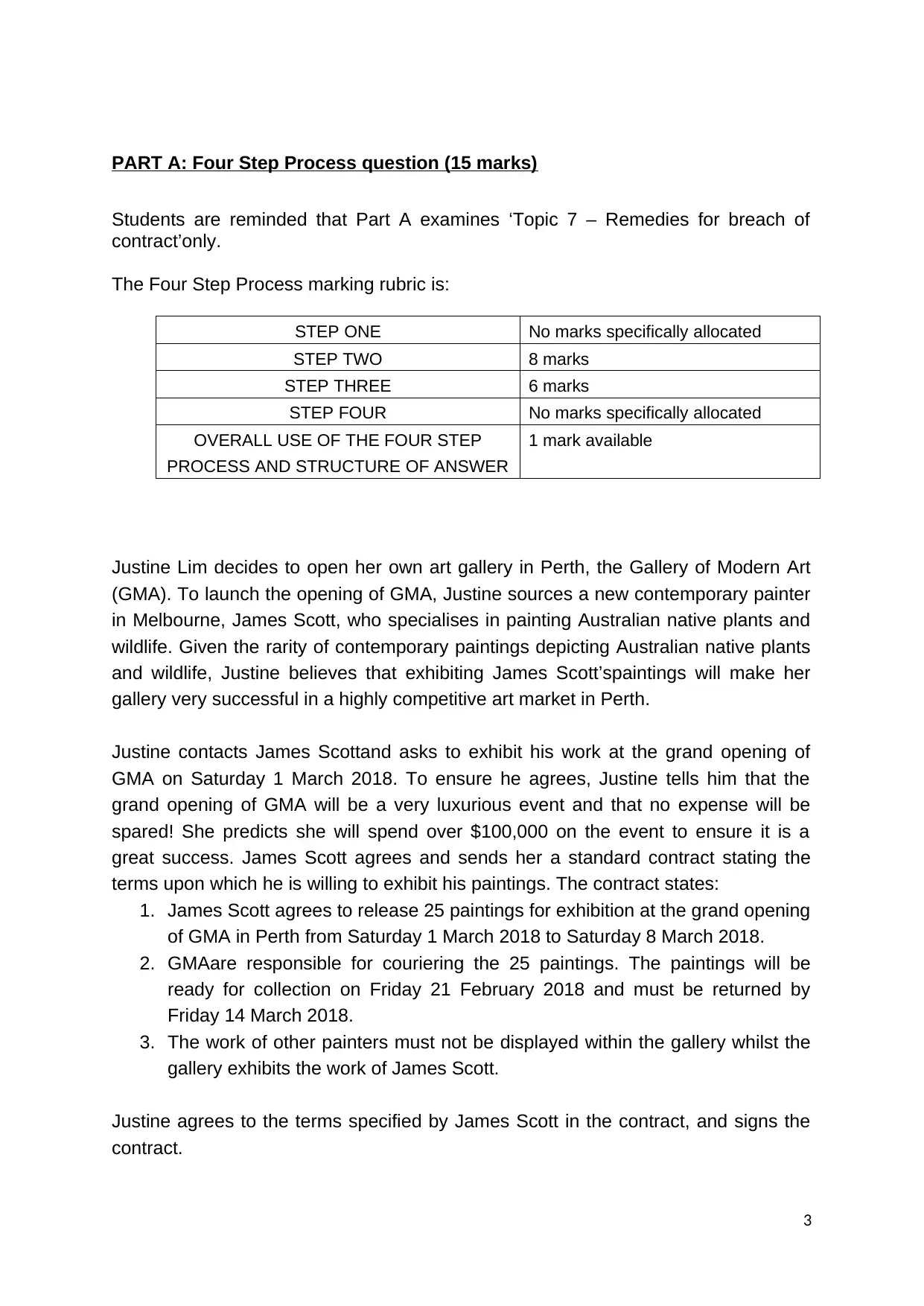
PART A: Four Step Process question (15 marks)
Students are reminded that Part A examines ‘Topic 7 – Remedies for breach of
contract’only.
The Four Step Process marking rubric is:
STEP ONE No marks specifically allocated
STEP TWO 8 marks
STEP THREE 6 marks
STEP FOUR No marks specifically allocated
OVERALL USE OF THE FOUR STEP
PROCESS AND STRUCTURE OF ANSWER
1 mark available
Justine Lim decides to open her own art gallery in Perth, the Gallery of Modern Art
(GMA). To launch the opening of GMA, Justine sources a new contemporary painter
in Melbourne, James Scott, who specialises in painting Australian native plants and
wildlife. Given the rarity of contemporary paintings depicting Australian native plants
and wildlife, Justine believes that exhibiting James Scott’spaintings will make her
gallery very successful in a highly competitive art market in Perth.
Justine contacts James Scottand asks to exhibit his work at the grand opening of
GMA on Saturday 1 March 2018. To ensure he agrees, Justine tells him that the
grand opening of GMA will be a very luxurious event and that no expense will be
spared! She predicts she will spend over $100,000 on the event to ensure it is a
great success. James Scott agrees and sends her a standard contract stating the
terms upon which he is willing to exhibit his paintings. The contract states:
1. James Scott agrees to release 25 paintings for exhibition at the grand opening
of GMA in Perth from Saturday 1 March 2018 to Saturday 8 March 2018.
2. GMAare responsible for couriering the 25 paintings. The paintings will be
ready for collection on Friday 21 February 2018 and must be returned by
Friday 14 March 2018.
3. The work of other painters must not be displayed within the gallery whilst the
gallery exhibits the work of James Scott.
Justine agrees to the terms specified by James Scott in the contract, and signs the
contract.
3
Students are reminded that Part A examines ‘Topic 7 – Remedies for breach of
contract’only.
The Four Step Process marking rubric is:
STEP ONE No marks specifically allocated
STEP TWO 8 marks
STEP THREE 6 marks
STEP FOUR No marks specifically allocated
OVERALL USE OF THE FOUR STEP
PROCESS AND STRUCTURE OF ANSWER
1 mark available
Justine Lim decides to open her own art gallery in Perth, the Gallery of Modern Art
(GMA). To launch the opening of GMA, Justine sources a new contemporary painter
in Melbourne, James Scott, who specialises in painting Australian native plants and
wildlife. Given the rarity of contemporary paintings depicting Australian native plants
and wildlife, Justine believes that exhibiting James Scott’spaintings will make her
gallery very successful in a highly competitive art market in Perth.
Justine contacts James Scottand asks to exhibit his work at the grand opening of
GMA on Saturday 1 March 2018. To ensure he agrees, Justine tells him that the
grand opening of GMA will be a very luxurious event and that no expense will be
spared! She predicts she will spend over $100,000 on the event to ensure it is a
great success. James Scott agrees and sends her a standard contract stating the
terms upon which he is willing to exhibit his paintings. The contract states:
1. James Scott agrees to release 25 paintings for exhibition at the grand opening
of GMA in Perth from Saturday 1 March 2018 to Saturday 8 March 2018.
2. GMAare responsible for couriering the 25 paintings. The paintings will be
ready for collection on Friday 21 February 2018 and must be returned by
Friday 14 March 2018.
3. The work of other painters must not be displayed within the gallery whilst the
gallery exhibits the work of James Scott.
Justine agrees to the terms specified by James Scott in the contract, and signs the
contract.
3
⊘ This is a preview!⊘
Do you want full access?
Subscribe today to unlock all pages.

Trusted by 1+ million students worldwide
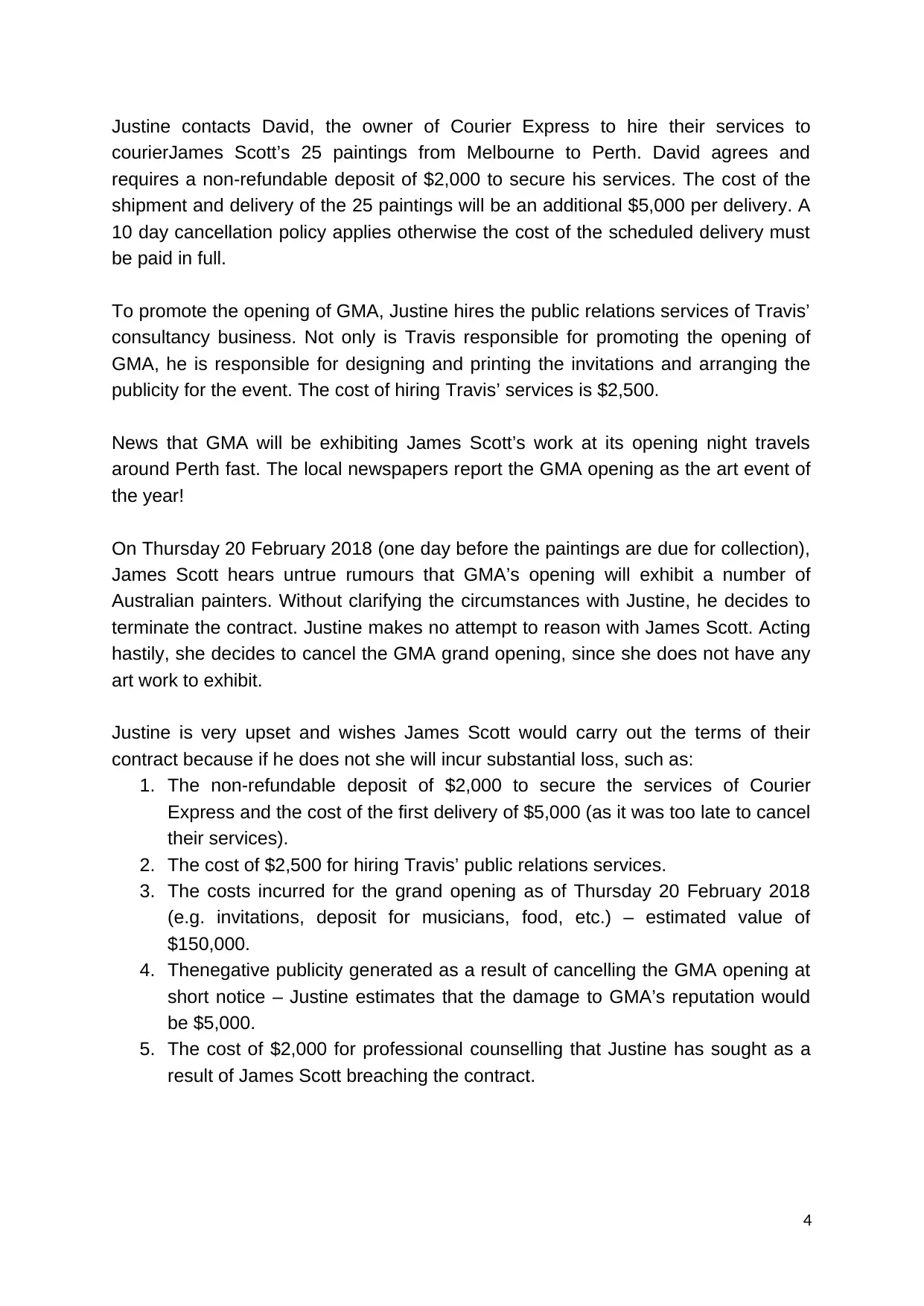
Justine contacts David, the owner of Courier Express to hire their services to
courierJames Scott’s 25 paintings from Melbourne to Perth. David agrees and
requires a non-refundable deposit of $2,000 to secure his services. The cost of the
shipment and delivery of the 25 paintings will be an additional $5,000 per delivery. A
10 day cancellation policy applies otherwise the cost of the scheduled delivery must
be paid in full.
To promote the opening of GMA, Justine hires the public relations services of Travis’
consultancy business. Not only is Travis responsible for promoting the opening of
GMA, he is responsible for designing and printing the invitations and arranging the
publicity for the event. The cost of hiring Travis’ services is $2,500.
News that GMA will be exhibiting James Scott’s work at its opening night travels
around Perth fast. The local newspapers report the GMA opening as the art event of
the year!
On Thursday 20 February 2018 (one day before the paintings are due for collection),
James Scott hears untrue rumours that GMA’s opening will exhibit a number of
Australian painters. Without clarifying the circumstances with Justine, he decides to
terminate the contract. Justine makes no attempt to reason with James Scott. Acting
hastily, she decides to cancel the GMA grand opening, since she does not have any
art work to exhibit.
Justine is very upset and wishes James Scott would carry out the terms of their
contract because if he does not she will incur substantial loss, such as:
1. The non-refundable deposit of $2,000 to secure the services of Courier
Express and the cost of the first delivery of $5,000 (as it was too late to cancel
their services).
2. The cost of $2,500 for hiring Travis’ public relations services.
3. The costs incurred for the grand opening as of Thursday 20 February 2018
(e.g. invitations, deposit for musicians, food, etc.) – estimated value of
$150,000.
4. Thenegative publicity generated as a result of cancelling the GMA opening at
short notice – Justine estimates that the damage to GMA’s reputation would
be $5,000.
5. The cost of $2,000 for professional counselling that Justine has sought as a
result of James Scott breaching the contract.
4
courierJames Scott’s 25 paintings from Melbourne to Perth. David agrees and
requires a non-refundable deposit of $2,000 to secure his services. The cost of the
shipment and delivery of the 25 paintings will be an additional $5,000 per delivery. A
10 day cancellation policy applies otherwise the cost of the scheduled delivery must
be paid in full.
To promote the opening of GMA, Justine hires the public relations services of Travis’
consultancy business. Not only is Travis responsible for promoting the opening of
GMA, he is responsible for designing and printing the invitations and arranging the
publicity for the event. The cost of hiring Travis’ services is $2,500.
News that GMA will be exhibiting James Scott’s work at its opening night travels
around Perth fast. The local newspapers report the GMA opening as the art event of
the year!
On Thursday 20 February 2018 (one day before the paintings are due for collection),
James Scott hears untrue rumours that GMA’s opening will exhibit a number of
Australian painters. Without clarifying the circumstances with Justine, he decides to
terminate the contract. Justine makes no attempt to reason with James Scott. Acting
hastily, she decides to cancel the GMA grand opening, since she does not have any
art work to exhibit.
Justine is very upset and wishes James Scott would carry out the terms of their
contract because if he does not she will incur substantial loss, such as:
1. The non-refundable deposit of $2,000 to secure the services of Courier
Express and the cost of the first delivery of $5,000 (as it was too late to cancel
their services).
2. The cost of $2,500 for hiring Travis’ public relations services.
3. The costs incurred for the grand opening as of Thursday 20 February 2018
(e.g. invitations, deposit for musicians, food, etc.) – estimated value of
$150,000.
4. Thenegative publicity generated as a result of cancelling the GMA opening at
short notice – Justine estimates that the damage to GMA’s reputation would
be $5,000.
5. The cost of $2,000 for professional counselling that Justine has sought as a
result of James Scott breaching the contract.
4
Paraphrase This Document
Need a fresh take? Get an instant paraphrase of this document with our AI Paraphraser
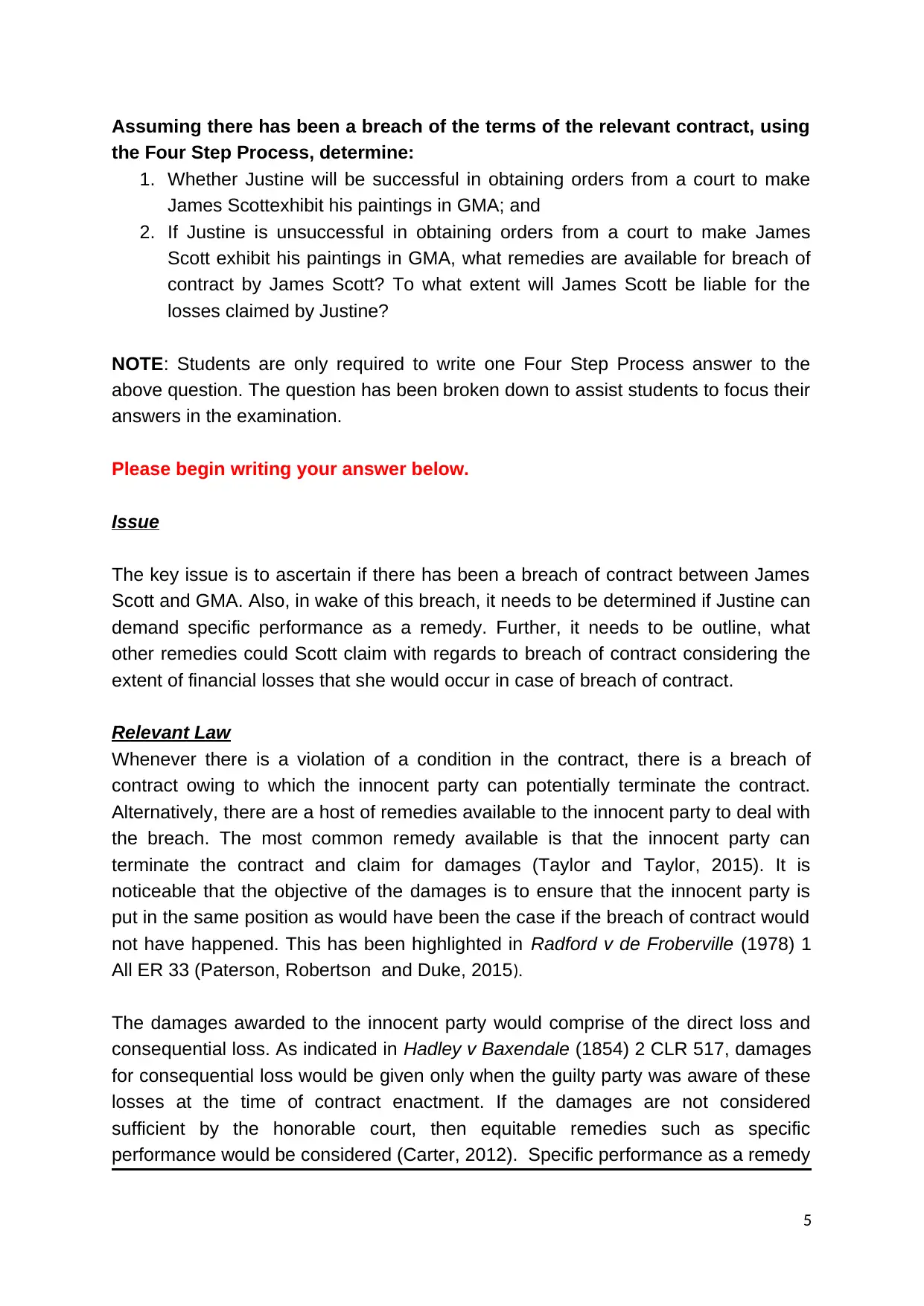
Assuming there has been a breach of the terms of the relevant contract, using
the Four Step Process, determine:
1. Whether Justine will be successful in obtaining orders from a court to make
James Scottexhibit his paintings in GMA; and
2. If Justine is unsuccessful in obtaining orders from a court to make James
Scott exhibit his paintings in GMA, what remedies are available for breach of
contract by James Scott? To what extent will James Scott be liable for the
losses claimed by Justine?
NOTE: Students are only required to write one Four Step Process answer to the
above question. The question has been broken down to assist students to focus their
answers in the examination.
Please begin writing your answer below.
Issue
The key issue is to ascertain if there has been a breach of contract between James
Scott and GMA. Also, in wake of this breach, it needs to be determined if Justine can
demand specific performance as a remedy. Further, it needs to be outline, what
other remedies could Scott claim with regards to breach of contract considering the
extent of financial losses that she would occur in case of breach of contract.
Relevant Law
Whenever there is a violation of a condition in the contract, there is a breach of
contract owing to which the innocent party can potentially terminate the contract.
Alternatively, there are a host of remedies available to the innocent party to deal with
the breach. The most common remedy available is that the innocent party can
terminate the contract and claim for damages (Taylor and Taylor, 2015). It is
noticeable that the objective of the damages is to ensure that the innocent party is
put in the same position as would have been the case if the breach of contract would
not have happened. This has been highlighted in Radford v de Froberville (1978) 1
All ER 33 (Paterson, Robertson and Duke, 2015).
The damages awarded to the innocent party would comprise of the direct loss and
consequential loss. As indicated in Hadley v Baxendale (1854) 2 CLR 517, damages
for consequential loss would be given only when the guilty party was aware of these
losses at the time of contract enactment. If the damages are not considered
sufficient by the honorable court, then equitable remedies such as specific
performance would be considered (Carter, 2012). Specific performance as a remedy
5
the Four Step Process, determine:
1. Whether Justine will be successful in obtaining orders from a court to make
James Scottexhibit his paintings in GMA; and
2. If Justine is unsuccessful in obtaining orders from a court to make James
Scott exhibit his paintings in GMA, what remedies are available for breach of
contract by James Scott? To what extent will James Scott be liable for the
losses claimed by Justine?
NOTE: Students are only required to write one Four Step Process answer to the
above question. The question has been broken down to assist students to focus their
answers in the examination.
Please begin writing your answer below.
Issue
The key issue is to ascertain if there has been a breach of contract between James
Scott and GMA. Also, in wake of this breach, it needs to be determined if Justine can
demand specific performance as a remedy. Further, it needs to be outline, what
other remedies could Scott claim with regards to breach of contract considering the
extent of financial losses that she would occur in case of breach of contract.
Relevant Law
Whenever there is a violation of a condition in the contract, there is a breach of
contract owing to which the innocent party can potentially terminate the contract.
Alternatively, there are a host of remedies available to the innocent party to deal with
the breach. The most common remedy available is that the innocent party can
terminate the contract and claim for damages (Taylor and Taylor, 2015). It is
noticeable that the objective of the damages is to ensure that the innocent party is
put in the same position as would have been the case if the breach of contract would
not have happened. This has been highlighted in Radford v de Froberville (1978) 1
All ER 33 (Paterson, Robertson and Duke, 2015).
The damages awarded to the innocent party would comprise of the direct loss and
consequential loss. As indicated in Hadley v Baxendale (1854) 2 CLR 517, damages
for consequential loss would be given only when the guilty party was aware of these
losses at the time of contract enactment. If the damages are not considered
sufficient by the honorable court, then equitable remedies such as specific
performance would be considered (Carter, 2012). Specific performance as a remedy
5
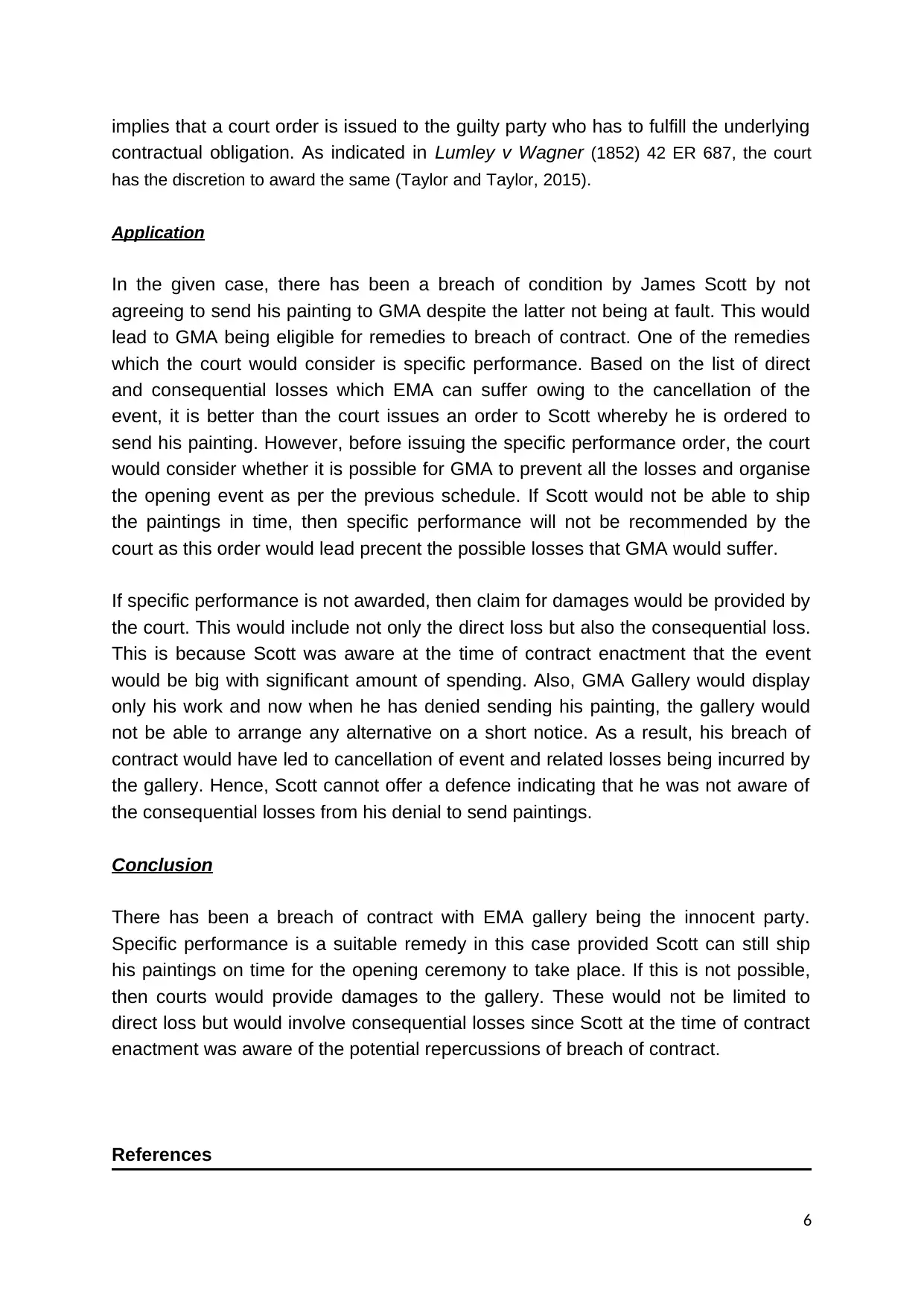
implies that a court order is issued to the guilty party who has to fulfill the underlying
contractual obligation. As indicated in Lumley v Wagner (1852) 42 ER 687, the court
has the discretion to award the same (Taylor and Taylor, 2015).
Application
In the given case, there has been a breach of condition by James Scott by not
agreeing to send his painting to GMA despite the latter not being at fault. This would
lead to GMA being eligible for remedies to breach of contract. One of the remedies
which the court would consider is specific performance. Based on the list of direct
and consequential losses which EMA can suffer owing to the cancellation of the
event, it is better than the court issues an order to Scott whereby he is ordered to
send his painting. However, before issuing the specific performance order, the court
would consider whether it is possible for GMA to prevent all the losses and organise
the opening event as per the previous schedule. If Scott would not be able to ship
the paintings in time, then specific performance will not be recommended by the
court as this order would lead precent the possible losses that GMA would suffer.
If specific performance is not awarded, then claim for damages would be provided by
the court. This would include not only the direct loss but also the consequential loss.
This is because Scott was aware at the time of contract enactment that the event
would be big with significant amount of spending. Also, GMA Gallery would display
only his work and now when he has denied sending his painting, the gallery would
not be able to arrange any alternative on a short notice. As a result, his breach of
contract would have led to cancellation of event and related losses being incurred by
the gallery. Hence, Scott cannot offer a defence indicating that he was not aware of
the consequential losses from his denial to send paintings.
Conclusion
There has been a breach of contract with EMA gallery being the innocent party.
Specific performance is a suitable remedy in this case provided Scott can still ship
his paintings on time for the opening ceremony to take place. If this is not possible,
then courts would provide damages to the gallery. These would not be limited to
direct loss but would involve consequential losses since Scott at the time of contract
enactment was aware of the potential repercussions of breach of contract.
References
6
contractual obligation. As indicated in Lumley v Wagner (1852) 42 ER 687, the court
has the discretion to award the same (Taylor and Taylor, 2015).
Application
In the given case, there has been a breach of condition by James Scott by not
agreeing to send his painting to GMA despite the latter not being at fault. This would
lead to GMA being eligible for remedies to breach of contract. One of the remedies
which the court would consider is specific performance. Based on the list of direct
and consequential losses which EMA can suffer owing to the cancellation of the
event, it is better than the court issues an order to Scott whereby he is ordered to
send his painting. However, before issuing the specific performance order, the court
would consider whether it is possible for GMA to prevent all the losses and organise
the opening event as per the previous schedule. If Scott would not be able to ship
the paintings in time, then specific performance will not be recommended by the
court as this order would lead precent the possible losses that GMA would suffer.
If specific performance is not awarded, then claim for damages would be provided by
the court. This would include not only the direct loss but also the consequential loss.
This is because Scott was aware at the time of contract enactment that the event
would be big with significant amount of spending. Also, GMA Gallery would display
only his work and now when he has denied sending his painting, the gallery would
not be able to arrange any alternative on a short notice. As a result, his breach of
contract would have led to cancellation of event and related losses being incurred by
the gallery. Hence, Scott cannot offer a defence indicating that he was not aware of
the consequential losses from his denial to send paintings.
Conclusion
There has been a breach of contract with EMA gallery being the innocent party.
Specific performance is a suitable remedy in this case provided Scott can still ship
his paintings on time for the opening ceremony to take place. If this is not possible,
then courts would provide damages to the gallery. These would not be limited to
direct loss but would involve consequential losses since Scott at the time of contract
enactment was aware of the potential repercussions of breach of contract.
References
6
⊘ This is a preview!⊘
Do you want full access?
Subscribe today to unlock all pages.

Trusted by 1+ million students worldwide
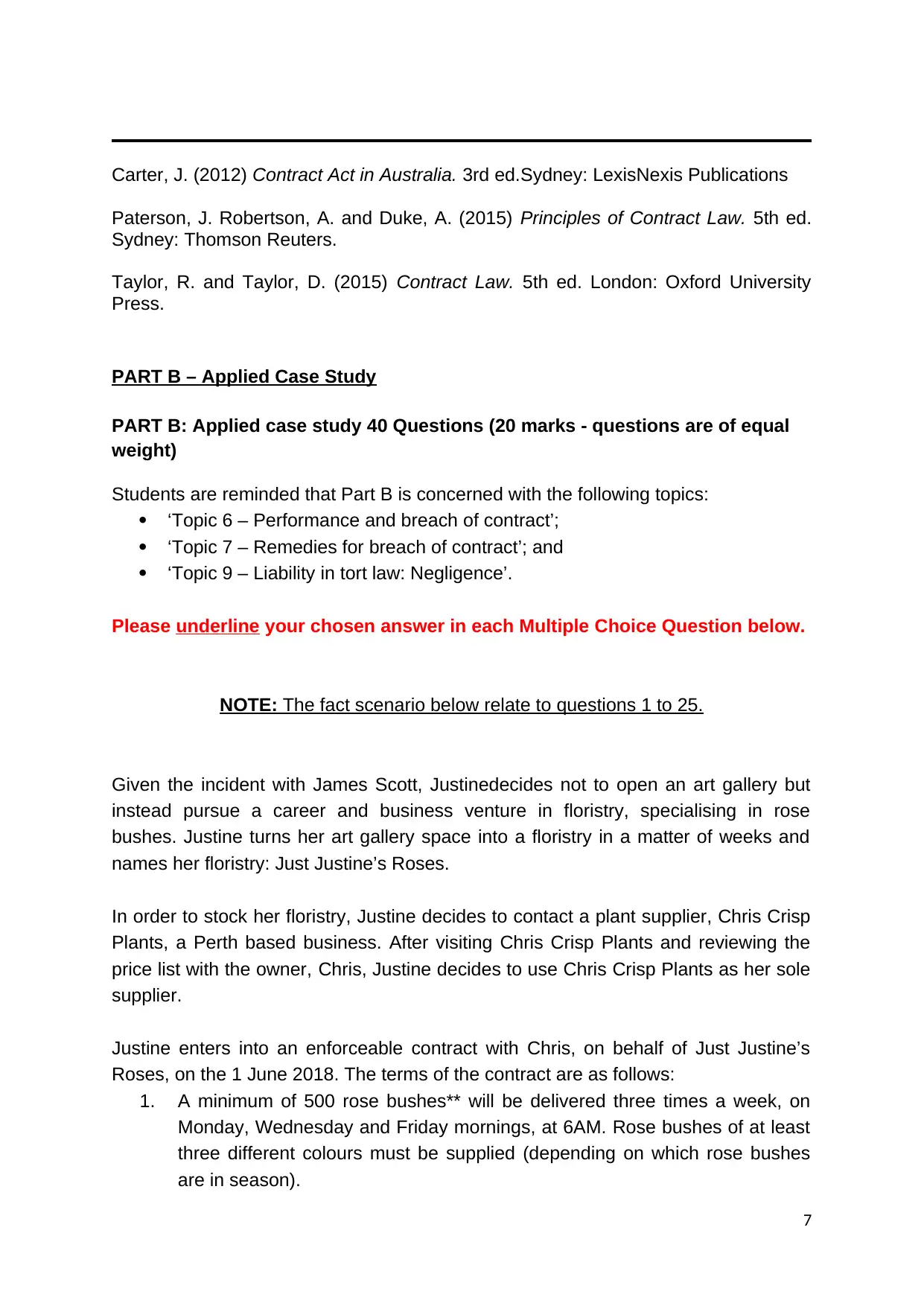
Carter, J. (2012) Contract Act in Australia. 3rd ed.Sydney: LexisNexis Publications
Paterson, J. Robertson, A. and Duke, A. (2015) Principles of Contract Law. 5th ed.
Sydney: Thomson Reuters.
Taylor, R. and Taylor, D. (2015) Contract Law. 5th ed. London: Oxford University
Press.
PART B – Applied Case Study
PART B: Applied case study 40 Questions (20 marks - questions are of equal
weight)
Students are reminded that Part B is concerned with the following topics:
‘Topic 6 – Performance and breach of contract’;
‘Topic 7 – Remedies for breach of contract’; and
‘Topic 9 – Liability in tort law: Negligence’.
Please underline your chosen answer in each Multiple Choice Question below.
NOTE: The fact scenario below relate to questions 1 to 25.
Given the incident with James Scott, Justinedecides not to open an art gallery but
instead pursue a career and business venture in floristry, specialising in rose
bushes. Justine turns her art gallery space into a floristry in a matter of weeks and
names her floristry: Just Justine’s Roses.
In order to stock her floristry, Justine decides to contact a plant supplier, Chris Crisp
Plants, a Perth based business. After visiting Chris Crisp Plants and reviewing the
price list with the owner, Chris, Justine decides to use Chris Crisp Plants as her sole
supplier.
Justine enters into an enforceable contract with Chris, on behalf of Just Justine’s
Roses, on the 1 June 2018. The terms of the contract are as follows:
1. A minimum of 500 rose bushes** will be delivered three times a week, on
Monday, Wednesday and Friday mornings, at 6AM. Rose bushes of at least
three different colours must be supplied (depending on which rose bushes
are in season).
7
Paterson, J. Robertson, A. and Duke, A. (2015) Principles of Contract Law. 5th ed.
Sydney: Thomson Reuters.
Taylor, R. and Taylor, D. (2015) Contract Law. 5th ed. London: Oxford University
Press.
PART B – Applied Case Study
PART B: Applied case study 40 Questions (20 marks - questions are of equal
weight)
Students are reminded that Part B is concerned with the following topics:
‘Topic 6 – Performance and breach of contract’;
‘Topic 7 – Remedies for breach of contract’; and
‘Topic 9 – Liability in tort law: Negligence’.
Please underline your chosen answer in each Multiple Choice Question below.
NOTE: The fact scenario below relate to questions 1 to 25.
Given the incident with James Scott, Justinedecides not to open an art gallery but
instead pursue a career and business venture in floristry, specialising in rose
bushes. Justine turns her art gallery space into a floristry in a matter of weeks and
names her floristry: Just Justine’s Roses.
In order to stock her floristry, Justine decides to contact a plant supplier, Chris Crisp
Plants, a Perth based business. After visiting Chris Crisp Plants and reviewing the
price list with the owner, Chris, Justine decides to use Chris Crisp Plants as her sole
supplier.
Justine enters into an enforceable contract with Chris, on behalf of Just Justine’s
Roses, on the 1 June 2018. The terms of the contract are as follows:
1. A minimum of 500 rose bushes** will be delivered three times a week, on
Monday, Wednesday and Friday mornings, at 6AM. Rose bushes of at least
three different colours must be supplied (depending on which rose bushes
are in season).
7
Paraphrase This Document
Need a fresh take? Get an instant paraphrase of this document with our AI Paraphraser
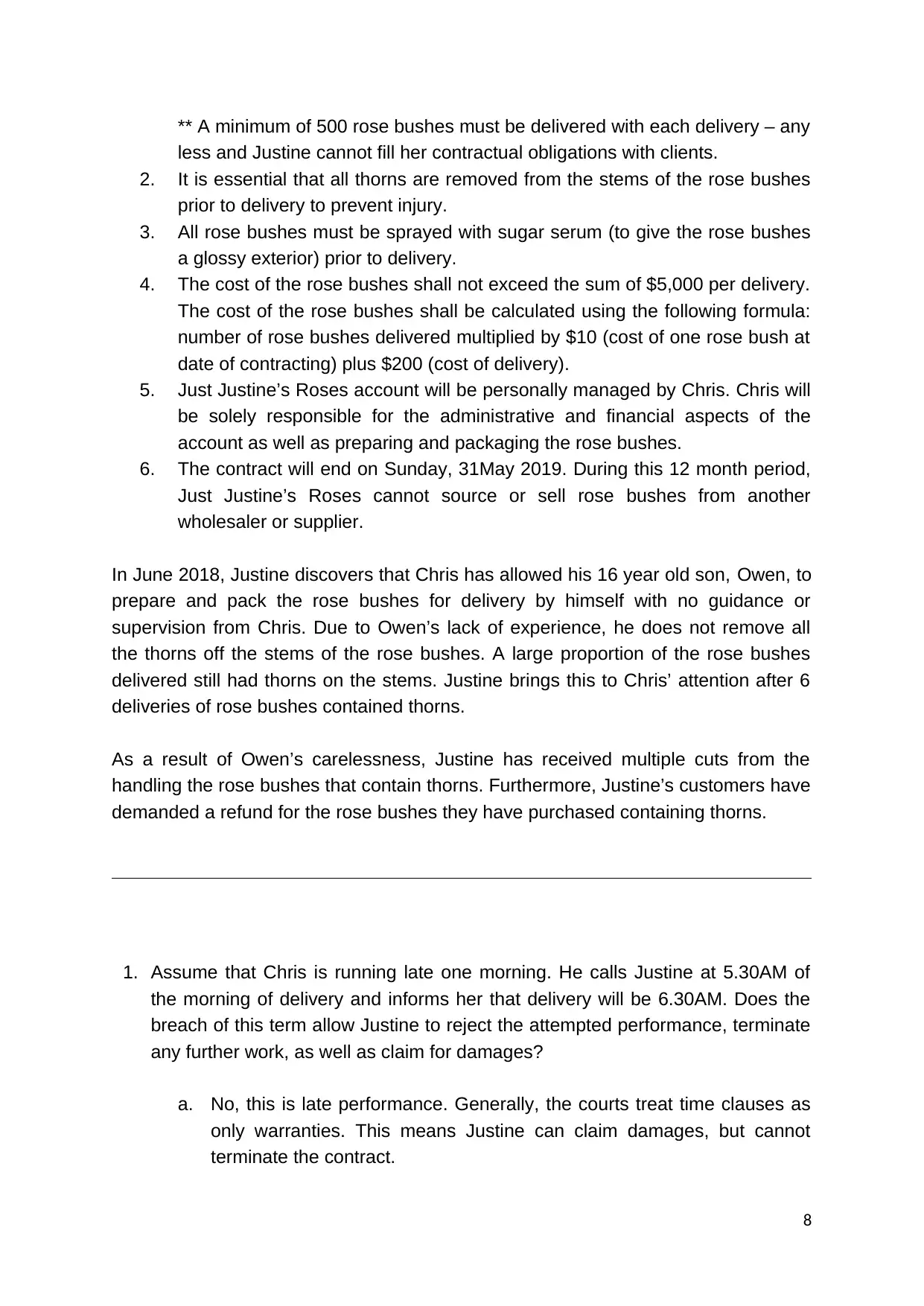
** A minimum of 500 rose bushes must be delivered with each delivery – any
less and Justine cannot fill her contractual obligations with clients.
2. It is essential that all thorns are removed from the stems of the rose bushes
prior to delivery to prevent injury.
3. All rose bushes must be sprayed with sugar serum (to give the rose bushes
a glossy exterior) prior to delivery.
4. The cost of the rose bushes shall not exceed the sum of $5,000 per delivery.
The cost of the rose bushes shall be calculated using the following formula:
number of rose bushes delivered multiplied by $10 (cost of one rose bush at
date of contracting) plus $200 (cost of delivery).
5. Just Justine’s Roses account will be personally managed by Chris. Chris will
be solely responsible for the administrative and financial aspects of the
account as well as preparing and packaging the rose bushes.
6. The contract will end on Sunday, 31May 2019. During this 12 month period,
Just Justine’s Roses cannot source or sell rose bushes from another
wholesaler or supplier.
In June 2018, Justine discovers that Chris has allowed his 16 year old son, Owen, to
prepare and pack the rose bushes for delivery by himself with no guidance or
supervision from Chris. Due to Owen’s lack of experience, he does not remove all
the thorns off the stems of the rose bushes. A large proportion of the rose bushes
delivered still had thorns on the stems. Justine brings this to Chris’ attention after 6
deliveries of rose bushes contained thorns.
As a result of Owen’s carelessness, Justine has received multiple cuts from the
handling the rose bushes that contain thorns. Furthermore, Justine’s customers have
demanded a refund for the rose bushes they have purchased containing thorns.
1. Assume that Chris is running late one morning. He calls Justine at 5.30AM of
the morning of delivery and informs her that delivery will be 6.30AM. Does the
breach of this term allow Justine to reject the attempted performance, terminate
any further work, as well as claim for damages?
a. No, this is late performance. Generally, the courts treat time clauses as
only warranties. This means Justine can claim damages, but cannot
terminate the contract.
8
less and Justine cannot fill her contractual obligations with clients.
2. It is essential that all thorns are removed from the stems of the rose bushes
prior to delivery to prevent injury.
3. All rose bushes must be sprayed with sugar serum (to give the rose bushes
a glossy exterior) prior to delivery.
4. The cost of the rose bushes shall not exceed the sum of $5,000 per delivery.
The cost of the rose bushes shall be calculated using the following formula:
number of rose bushes delivered multiplied by $10 (cost of one rose bush at
date of contracting) plus $200 (cost of delivery).
5. Just Justine’s Roses account will be personally managed by Chris. Chris will
be solely responsible for the administrative and financial aspects of the
account as well as preparing and packaging the rose bushes.
6. The contract will end on Sunday, 31May 2019. During this 12 month period,
Just Justine’s Roses cannot source or sell rose bushes from another
wholesaler or supplier.
In June 2018, Justine discovers that Chris has allowed his 16 year old son, Owen, to
prepare and pack the rose bushes for delivery by himself with no guidance or
supervision from Chris. Due to Owen’s lack of experience, he does not remove all
the thorns off the stems of the rose bushes. A large proportion of the rose bushes
delivered still had thorns on the stems. Justine brings this to Chris’ attention after 6
deliveries of rose bushes contained thorns.
As a result of Owen’s carelessness, Justine has received multiple cuts from the
handling the rose bushes that contain thorns. Furthermore, Justine’s customers have
demanded a refund for the rose bushes they have purchased containing thorns.
1. Assume that Chris is running late one morning. He calls Justine at 5.30AM of
the morning of delivery and informs her that delivery will be 6.30AM. Does the
breach of this term allow Justine to reject the attempted performance, terminate
any further work, as well as claim for damages?
a. No, this is late performance. Generally, the courts treat time clauses as
only warranties. This means Justine can claim damages, but cannot
terminate the contract.
8
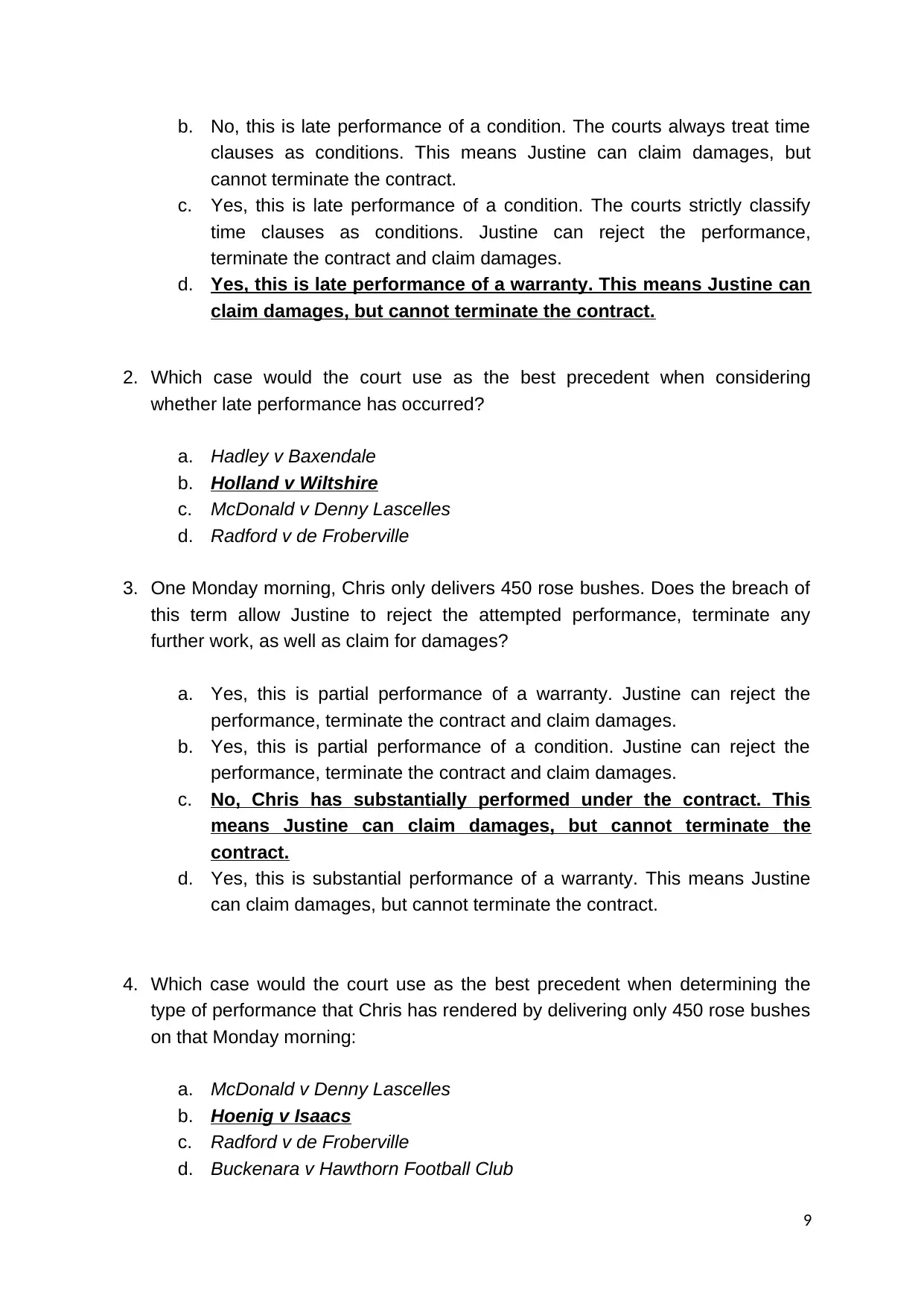
b. No, this is late performance of a condition. The courts always treat time
clauses as conditions. This means Justine can claim damages, but
cannot terminate the contract.
c. Yes, this is late performance of a condition. The courts strictly classify
time clauses as conditions. Justine can reject the performance,
terminate the contract and claim damages.
d. Yes, this is late performance of a warranty. This means Justine can
claim damages, but cannot terminate the contract.
2. Which case would the court use as the best precedent when considering
whether late performance has occurred?
a. Hadley v Baxendale
b. Holland v Wiltshire
c. McDonald v Denny Lascelles
d. Radford v de Froberville
3. One Monday morning, Chris only delivers 450 rose bushes. Does the breach of
this term allow Justine to reject the attempted performance, terminate any
further work, as well as claim for damages?
a. Yes, this is partial performance of a warranty. Justine can reject the
performance, terminate the contract and claim damages.
b. Yes, this is partial performance of a condition. Justine can reject the
performance, terminate the contract and claim damages.
c. No, Chris has substantially performed under the contract. This
means Justine can claim damages, but cannot terminate the
contract.
d. Yes, this is substantial performance of a warranty. This means Justine
can claim damages, but cannot terminate the contract.
4. Which case would the court use as the best precedent when determining the
type of performance that Chris has rendered by delivering only 450 rose bushes
on that Monday morning:
a. McDonald v Denny Lascelles
b. Hoenig v Isaacs
c. Radford v de Froberville
d. Buckenara v Hawthorn Football Club
9
clauses as conditions. This means Justine can claim damages, but
cannot terminate the contract.
c. Yes, this is late performance of a condition. The courts strictly classify
time clauses as conditions. Justine can reject the performance,
terminate the contract and claim damages.
d. Yes, this is late performance of a warranty. This means Justine can
claim damages, but cannot terminate the contract.
2. Which case would the court use as the best precedent when considering
whether late performance has occurred?
a. Hadley v Baxendale
b. Holland v Wiltshire
c. McDonald v Denny Lascelles
d. Radford v de Froberville
3. One Monday morning, Chris only delivers 450 rose bushes. Does the breach of
this term allow Justine to reject the attempted performance, terminate any
further work, as well as claim for damages?
a. Yes, this is partial performance of a warranty. Justine can reject the
performance, terminate the contract and claim damages.
b. Yes, this is partial performance of a condition. Justine can reject the
performance, terminate the contract and claim damages.
c. No, Chris has substantially performed under the contract. This
means Justine can claim damages, but cannot terminate the
contract.
d. Yes, this is substantial performance of a warranty. This means Justine
can claim damages, but cannot terminate the contract.
4. Which case would the court use as the best precedent when determining the
type of performance that Chris has rendered by delivering only 450 rose bushes
on that Monday morning:
a. McDonald v Denny Lascelles
b. Hoenig v Isaacs
c. Radford v de Froberville
d. Buckenara v Hawthorn Football Club
9
⊘ This is a preview!⊘
Do you want full access?
Subscribe today to unlock all pages.

Trusted by 1+ million students worldwide
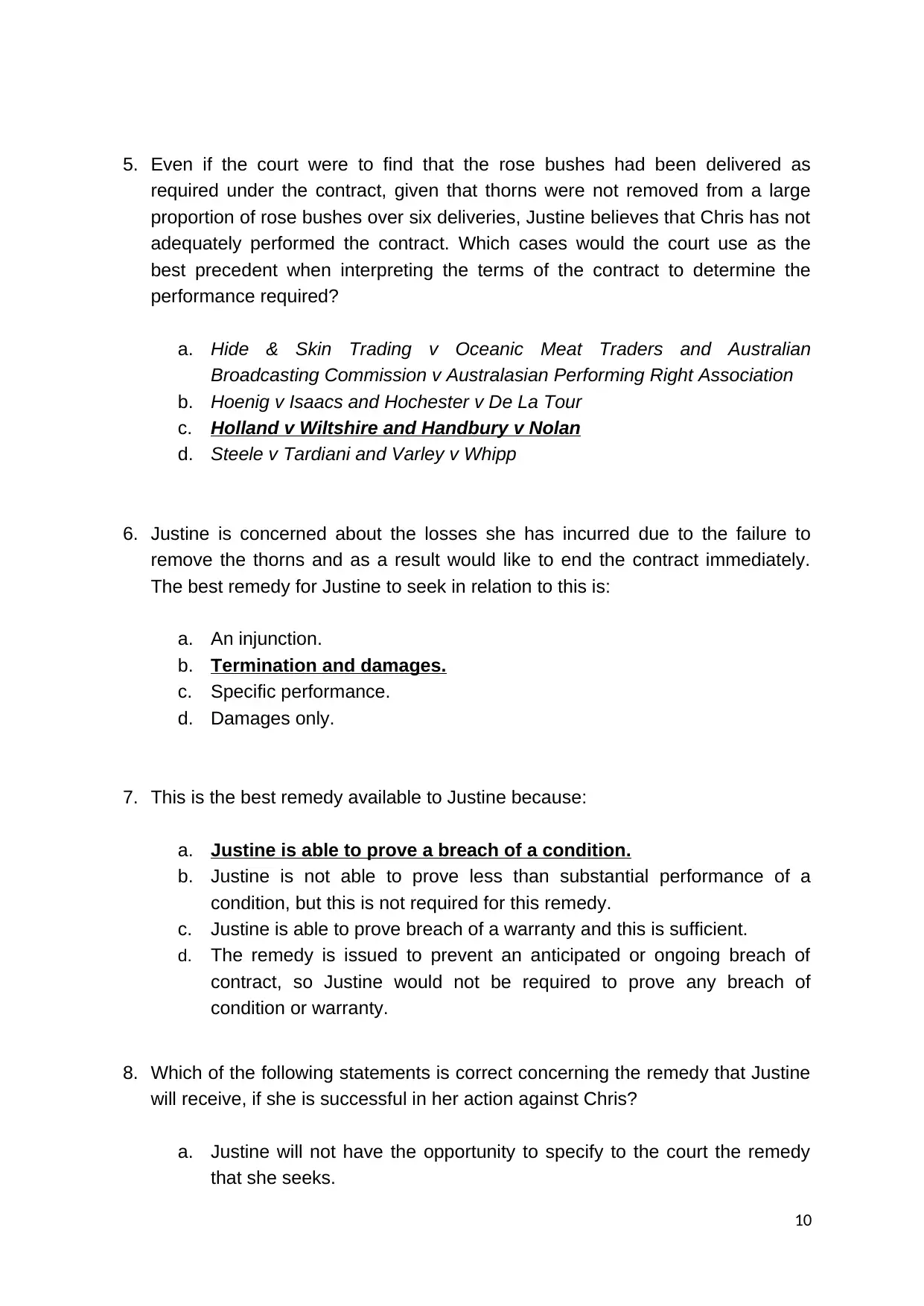
5. Even if the court were to find that the rose bushes had been delivered as
required under the contract, given that thorns were not removed from a large
proportion of rose bushes over six deliveries, Justine believes that Chris has not
adequately performed the contract. Which cases would the court use as the
best precedent when interpreting the terms of the contract to determine the
performance required?
a. Hide & Skin Trading v Oceanic Meat Traders and Australian
Broadcasting Commission v Australasian Performing Right Association
b. Hoenig v Isaacs and Hochester v De La Tour
c. Holland v Wiltshire and Handbury v Nolan
d. Steele v Tardiani and Varley v Whipp
6. Justine is concerned about the losses she has incurred due to the failure to
remove the thorns and as a result would like to end the contract immediately.
The best remedy for Justine to seek in relation to this is:
a. An injunction.
b. Termination and damages.
c. Specific performance.
d. Damages only.
7. This is the best remedy available to Justine because:
a. Justine is able to prove a breach of a condition.
b. Justine is not able to prove less than substantial performance of a
condition, but this is not required for this remedy.
c. Justine is able to prove breach of a warranty and this is sufficient.
d. The remedy is issued to prevent an anticipated or ongoing breach of
contract, so Justine would not be required to prove any breach of
condition or warranty.
8. Which of the following statements is correct concerning the remedy that Justine
will receive, if she is successful in her action against Chris?
a. Justine will not have the opportunity to specify to the court the remedy
that she seeks.
10
required under the contract, given that thorns were not removed from a large
proportion of rose bushes over six deliveries, Justine believes that Chris has not
adequately performed the contract. Which cases would the court use as the
best precedent when interpreting the terms of the contract to determine the
performance required?
a. Hide & Skin Trading v Oceanic Meat Traders and Australian
Broadcasting Commission v Australasian Performing Right Association
b. Hoenig v Isaacs and Hochester v De La Tour
c. Holland v Wiltshire and Handbury v Nolan
d. Steele v Tardiani and Varley v Whipp
6. Justine is concerned about the losses she has incurred due to the failure to
remove the thorns and as a result would like to end the contract immediately.
The best remedy for Justine to seek in relation to this is:
a. An injunction.
b. Termination and damages.
c. Specific performance.
d. Damages only.
7. This is the best remedy available to Justine because:
a. Justine is able to prove a breach of a condition.
b. Justine is not able to prove less than substantial performance of a
condition, but this is not required for this remedy.
c. Justine is able to prove breach of a warranty and this is sufficient.
d. The remedy is issued to prevent an anticipated or ongoing breach of
contract, so Justine would not be required to prove any breach of
condition or warranty.
8. Which of the following statements is correct concerning the remedy that Justine
will receive, if she is successful in her action against Chris?
a. Justine will not have the opportunity to specify to the court the remedy
that she seeks.
10
Paraphrase This Document
Need a fresh take? Get an instant paraphrase of this document with our AI Paraphraser
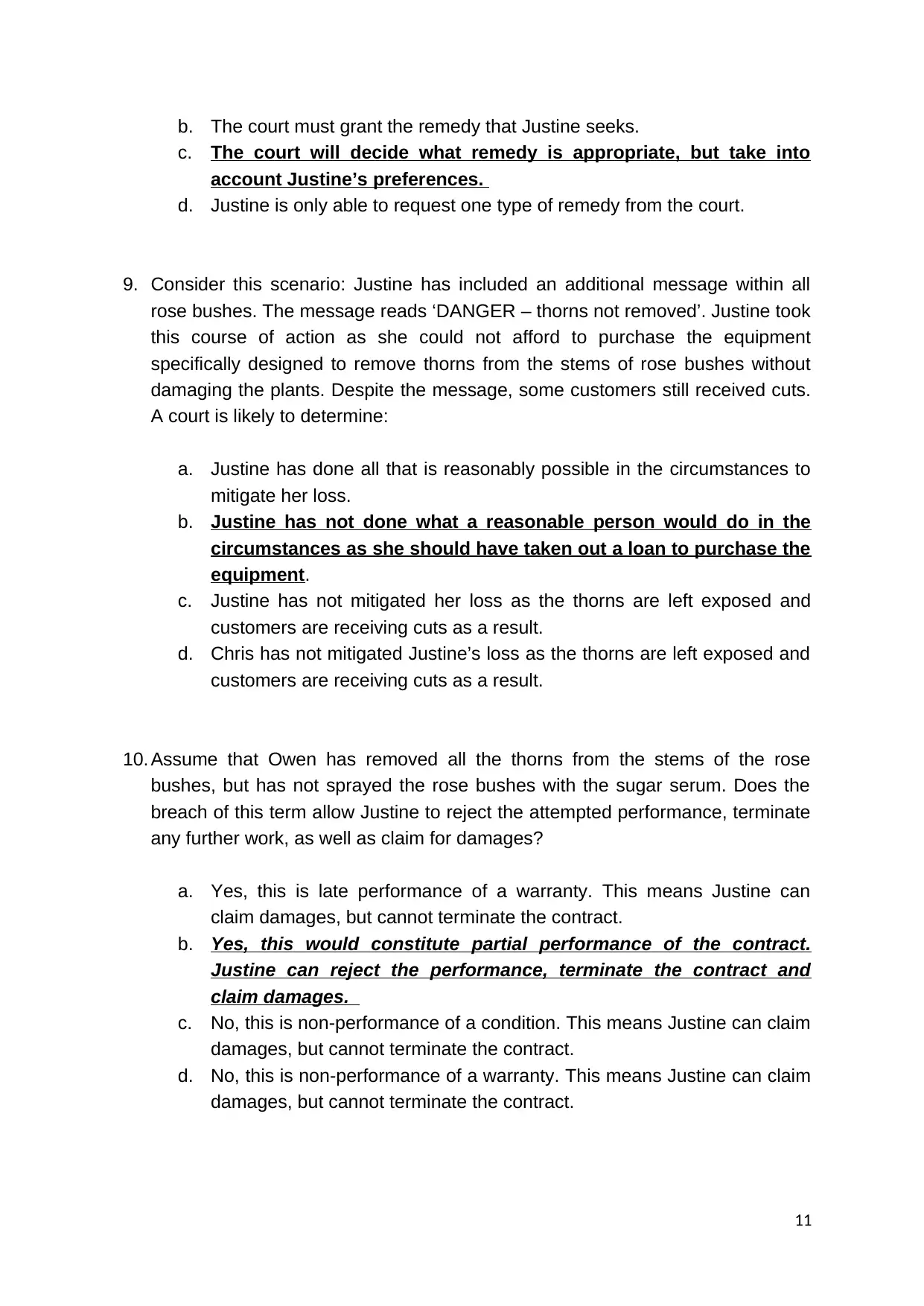
b. The court must grant the remedy that Justine seeks.
c. The court will decide what remedy is appropriate, but take into
account Justine’s preferences.
d. Justine is only able to request one type of remedy from the court.
9. Consider this scenario: Justine has included an additional message within all
rose bushes. The message reads ‘DANGER – thorns not removed’. Justine took
this course of action as she could not afford to purchase the equipment
specifically designed to remove thorns from the stems of rose bushes without
damaging the plants. Despite the message, some customers still received cuts.
A court is likely to determine:
a. Justine has done all that is reasonably possible in the circumstances to
mitigate her loss.
b. Justine has not done what a reasonable person would do in the
circumstances as she should have taken out a loan to purchase the
equipment.
c. Justine has not mitigated her loss as the thorns are left exposed and
customers are receiving cuts as a result.
d. Chris has not mitigated Justine’s loss as the thorns are left exposed and
customers are receiving cuts as a result.
10. Assume that Owen has removed all the thorns from the stems of the rose
bushes, but has not sprayed the rose bushes with the sugar serum. Does the
breach of this term allow Justine to reject the attempted performance, terminate
any further work, as well as claim for damages?
a. Yes, this is late performance of a warranty. This means Justine can
claim damages, but cannot terminate the contract.
b. Yes, this would constitute partial performance of the contract.
Justine can reject the performance, terminate the contract and
claim damages.
c. No, this is non-performance of a condition. This means Justine can claim
damages, but cannot terminate the contract.
d. No, this is non-performance of a warranty. This means Justine can claim
damages, but cannot terminate the contract.
11
c. The court will decide what remedy is appropriate, but take into
account Justine’s preferences.
d. Justine is only able to request one type of remedy from the court.
9. Consider this scenario: Justine has included an additional message within all
rose bushes. The message reads ‘DANGER – thorns not removed’. Justine took
this course of action as she could not afford to purchase the equipment
specifically designed to remove thorns from the stems of rose bushes without
damaging the plants. Despite the message, some customers still received cuts.
A court is likely to determine:
a. Justine has done all that is reasonably possible in the circumstances to
mitigate her loss.
b. Justine has not done what a reasonable person would do in the
circumstances as she should have taken out a loan to purchase the
equipment.
c. Justine has not mitigated her loss as the thorns are left exposed and
customers are receiving cuts as a result.
d. Chris has not mitigated Justine’s loss as the thorns are left exposed and
customers are receiving cuts as a result.
10. Assume that Owen has removed all the thorns from the stems of the rose
bushes, but has not sprayed the rose bushes with the sugar serum. Does the
breach of this term allow Justine to reject the attempted performance, terminate
any further work, as well as claim for damages?
a. Yes, this is late performance of a warranty. This means Justine can
claim damages, but cannot terminate the contract.
b. Yes, this would constitute partial performance of the contract.
Justine can reject the performance, terminate the contract and
claim damages.
c. No, this is non-performance of a condition. This means Justine can claim
damages, but cannot terminate the contract.
d. No, this is non-performance of a warranty. This means Justine can claim
damages, but cannot terminate the contract.
11
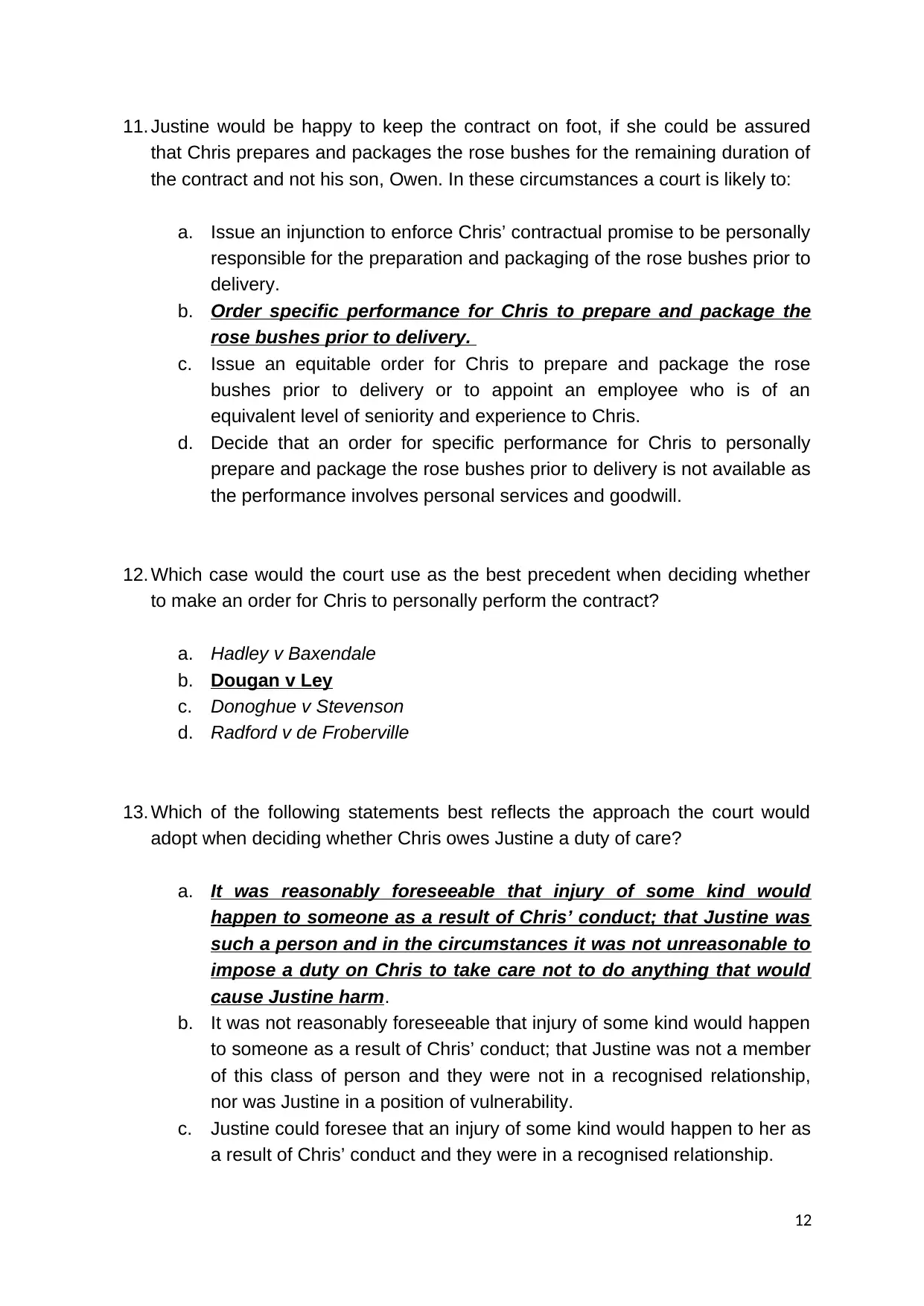
11. Justine would be happy to keep the contract on foot, if she could be assured
that Chris prepares and packages the rose bushes for the remaining duration of
the contract and not his son, Owen. In these circumstances a court is likely to:
a. Issue an injunction to enforce Chris’ contractual promise to be personally
responsible for the preparation and packaging of the rose bushes prior to
delivery.
b. Order specific performance for Chris to prepare and package the
rose bushes prior to delivery.
c. Issue an equitable order for Chris to prepare and package the rose
bushes prior to delivery or to appoint an employee who is of an
equivalent level of seniority and experience to Chris.
d. Decide that an order for specific performance for Chris to personally
prepare and package the rose bushes prior to delivery is not available as
the performance involves personal services and goodwill.
12. Which case would the court use as the best precedent when deciding whether
to make an order for Chris to personally perform the contract?
a. Hadley v Baxendale
b. Dougan v Ley
c. Donoghue v Stevenson
d. Radford v de Froberville
13. Which of the following statements best reflects the approach the court would
adopt when deciding whether Chris owes Justine a duty of care?
a. It was reasonably foreseeable that injury of some kind would
happen to someone as a result of Chris’ conduct; that Justine was
such a person and in the circumstances it was not unreasonable to
impose a duty on Chris to take care not to do anything that would
cause Justine harm.
b. It was not reasonably foreseeable that injury of some kind would happen
to someone as a result of Chris’ conduct; that Justine was not a member
of this class of person and they were not in a recognised relationship,
nor was Justine in a position of vulnerability.
c. Justine could foresee that an injury of some kind would happen to her as
a result of Chris’ conduct and they were in a recognised relationship.
12
that Chris prepares and packages the rose bushes for the remaining duration of
the contract and not his son, Owen. In these circumstances a court is likely to:
a. Issue an injunction to enforce Chris’ contractual promise to be personally
responsible for the preparation and packaging of the rose bushes prior to
delivery.
b. Order specific performance for Chris to prepare and package the
rose bushes prior to delivery.
c. Issue an equitable order for Chris to prepare and package the rose
bushes prior to delivery or to appoint an employee who is of an
equivalent level of seniority and experience to Chris.
d. Decide that an order for specific performance for Chris to personally
prepare and package the rose bushes prior to delivery is not available as
the performance involves personal services and goodwill.
12. Which case would the court use as the best precedent when deciding whether
to make an order for Chris to personally perform the contract?
a. Hadley v Baxendale
b. Dougan v Ley
c. Donoghue v Stevenson
d. Radford v de Froberville
13. Which of the following statements best reflects the approach the court would
adopt when deciding whether Chris owes Justine a duty of care?
a. It was reasonably foreseeable that injury of some kind would
happen to someone as a result of Chris’ conduct; that Justine was
such a person and in the circumstances it was not unreasonable to
impose a duty on Chris to take care not to do anything that would
cause Justine harm.
b. It was not reasonably foreseeable that injury of some kind would happen
to someone as a result of Chris’ conduct; that Justine was not a member
of this class of person and they were not in a recognised relationship,
nor was Justine in a position of vulnerability.
c. Justine could foresee that an injury of some kind would happen to her as
a result of Chris’ conduct and they were in a recognised relationship.
12
⊘ This is a preview!⊘
Do you want full access?
Subscribe today to unlock all pages.

Trusted by 1+ million students worldwide
1 out of 25
Your All-in-One AI-Powered Toolkit for Academic Success.
+13062052269
info@desklib.com
Available 24*7 on WhatsApp / Email
![[object Object]](/_next/static/media/star-bottom.7253800d.svg)
Unlock your academic potential
Copyright © 2020–2025 A2Z Services. All Rights Reserved. Developed and managed by ZUCOL.